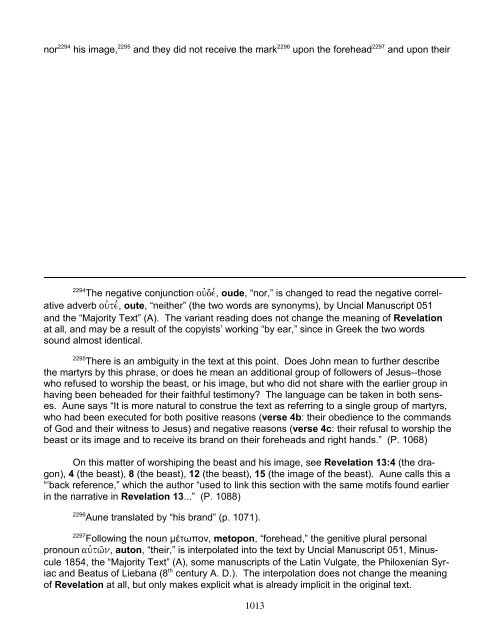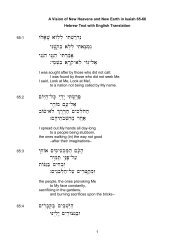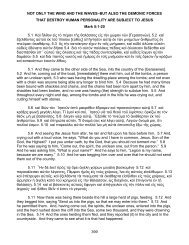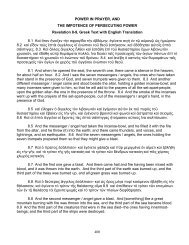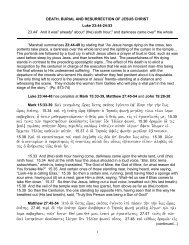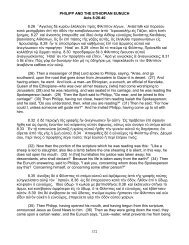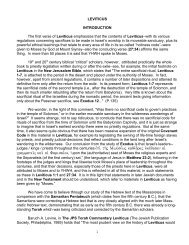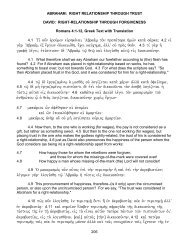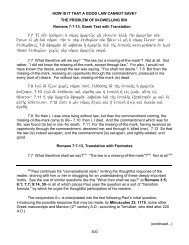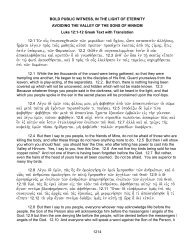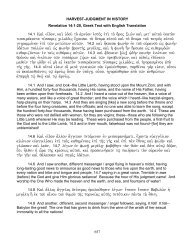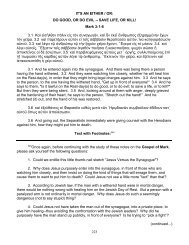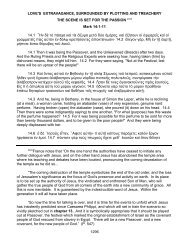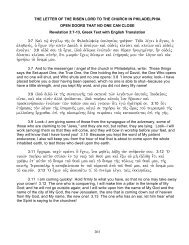Revelation 20 - In Depth Bible Commentaries
Revelation 20 - In Depth Bible Commentaries
Revelation 20 - In Depth Bible Commentaries
You also want an ePaper? Increase the reach of your titles
YUMPU automatically turns print PDFs into web optimized ePapers that Google loves.
2294 2295 2296 2297<br />
nor his image, and they did not receive the mark upon the forehead and upon their<br />
2294<br />
The negative conjunction ouvde, oude, “nor,” is changed to read the negative correlative<br />
adverb ouvte, oute, “neither” (the two words are synonyms), by Uncial Manuscript 051<br />
and the “Majority Text” (A). The variant reading does not change the meaning of <strong>Revelation</strong><br />
at all, and may be a result of the copyists’ working “by ear,” since in Greek the two words<br />
sound almost identical.<br />
2295<br />
There is an ambiguity in the text at this point. Does John mean to further describe<br />
the martyrs by this phrase, or does he mean an additional group of followers of Jesus--those<br />
who refused to worship the beast, or his image, but who did not share with the earlier group in<br />
having been beheaded for their faithful testimony? The language can be taken in both senses.<br />
Aune says “It is more natural to construe the text as referring to a single group of martyrs,<br />
who had been executed for both positive reasons (verse 4b: their obedience to the commands<br />
of God and their witness to Jesus) and negative reasons (verse 4c: their refusal to worship the<br />
beast or its image and to receive its brand on their foreheads and right hands.” (P. 1068)<br />
On this matter of worshiping the beast and his image, see <strong>Revelation</strong> 13:4 (the dragon),<br />
4 (the beast), 8 (the beast), 12 (the beast), 15 (the image of the beast). Aune calls this a<br />
“‘back reference,” which the author “used to link this section with the same motifs found earlier<br />
in the narrative in <strong>Revelation</strong> 13...” (P. 1088)<br />
2296<br />
Aune translated by “his brand” (p. 1071).<br />
2297<br />
Following the noun ìÝôùðïí, metopon, “forehead,” the genitive plural personal<br />
pronoun auvtw/n, auton, “their,” is interpolated into the text by Uncial Manuscript 051, Minuscule<br />
1854, the “Majority Text” (A), some manuscripts of the Latin Vulgate, the Philoxenian Syriac<br />
and Beatus of Liebana (8 century A. D.). The interpolation does not change the meaning<br />
th<br />
of <strong>Revelation</strong> at all, but only makes explicit what is already implicit in the original text.<br />
1013


